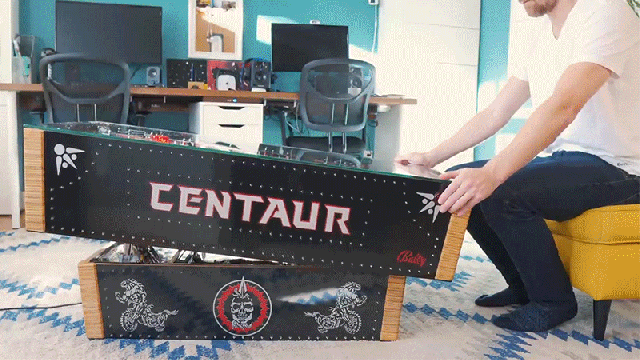The sounds, the lights, and even the satisfying feel of the flipper in action easily explain why pinball remains popular to this day. But like Adrian Atwood, few of us have the room for a full-size pinball machine at home. Atwood’s solution was to convert an old table into a double-duty coffee table, and as impressive as the results are, the work that went into the conversion is unbelievable.
If you’re going to spend months modifying, upgrading, and repurposing a pinball machine, the hardest part is undoubtedly the very first step: deciding what pinball machine to use. Atwood chose Centaur, a 1980 solid-state table from Bally featuring horror-themed graphics and gameplay that centered around destroying a half-man-half-motorcycle centaur. Sealing the deal was the fact that Centaur used a TMS5000 speech synthesis chip from Texas Instruments, which was very similar to the chip that powered the popular talking Speak & Spell toy.
Turning a pinball machine into a coffee table isn’t as easy as it sounds. The game’s vertical backboard had to be eliminated, which required a bunch of electronics to be relocated, and the addition of extra screens squeezed around the playfield for displaying high scores and other, more advanced functionality Atwood added.
Pinball machines are also fundamentally gravity-powered, but a coffee table with an angled top would send coffee cups and TV remotes sliding off onto the floor. So Atwood built an entirely custom cabinet with an electronic lift powered by linear actuators that elevate the pinball playfield at one end. They went one step further and even added a dial that players can use to adjust the exact angle of the table, allowing for increased difficulty the steeper the angle gets.
The 15-minute build video goes into a lot of detail about all of the electronic repairs and upgrades the table needed to both work as well as it did the day it left the Bally factory, but to also work with more modern upgrades like OLED screens. But if you really want to dig into all of the work Atwood had to do, the build is detailed on their website as well for those obsessed with pinball enough to do their own coffee table conversion.

Comments